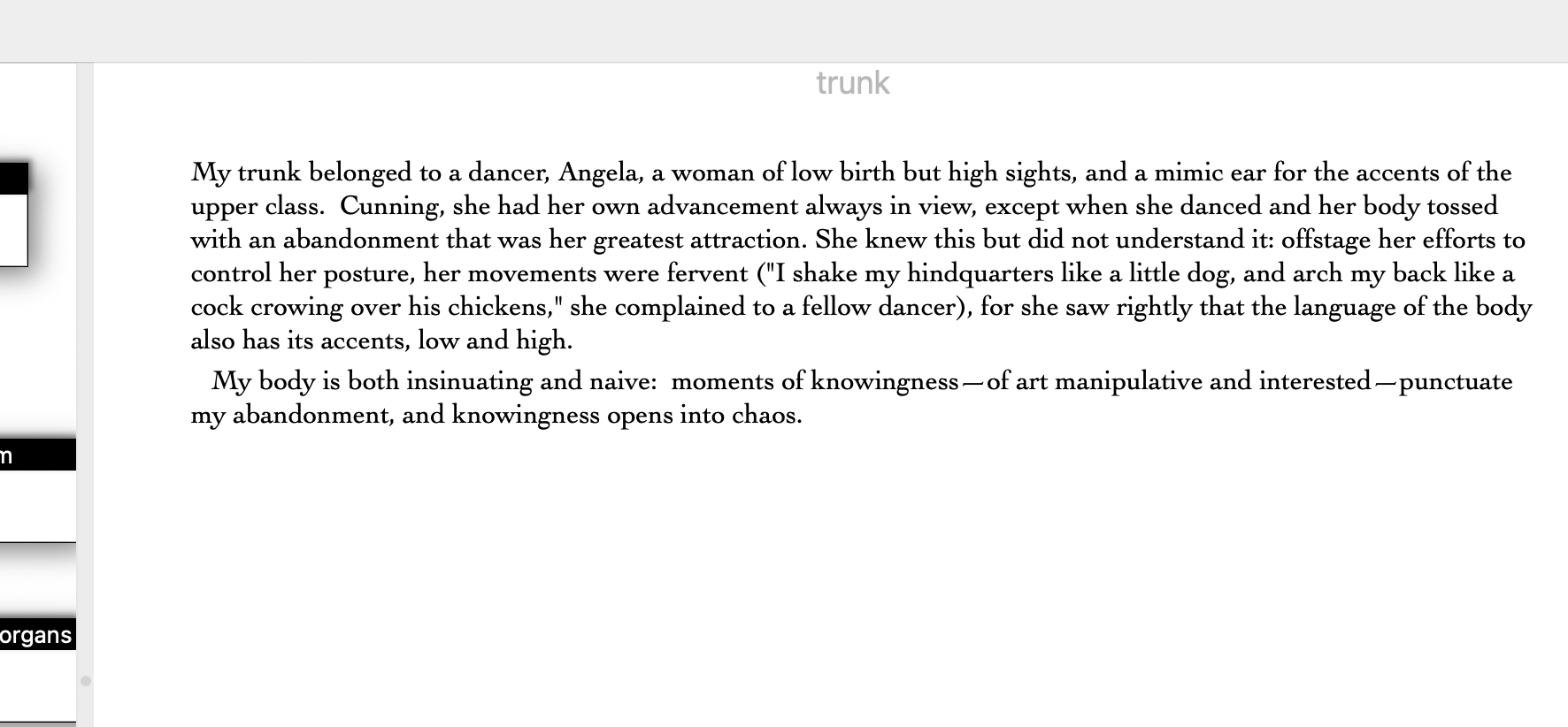The Woods, Part I
Hangsaman’s first portion abruptly ruptures, shifts, and quietly begins to unstitch the already-fragile seams of Natalie’s psyche and voice, and, concurrently, the narrative structure starts to disassemble even as it constantly works to patch itself back together. This unstitching arrives not via the telling of any explicit or dramatic events, exactly, but rather, through the conspicuous not-telling of a series of traumatic moments. One of these crucial moments comes midway through the first chapter, and reverberates through the rest of the plot, affecting Natalie’s voice and how her focalization functions from then on.
Arnold Waite throws an appropriately pretentious cocktail party for his literary entourage, organized entirely by his exhausted wife, and Natalie, after getting slightly drunk, is approached by one of the men at the party, ostensibly a fellow writer and friend of her father’s. This man provokes Natalie’s curiosity, and she describes him in distinctly indistinct terms: “older than she thought,” (38) and “strange,” but mentions almost no specific features. After a dull conversation, he coaxes her into moving away from the party and into the “little forest” that borders the periphery of Natalie’s backyard, and, slowly, the palpable current of general unease transforms into a more sinister interaction:
“I used to play in here when I was a child,” she said. Then they were into the little forest, and the trees were really dark and silent, and Natalie thought quickly, The danger is here, in here, just as they stepped inside and were lost in the darkness. What have I done? she wondered, walking silently among the trees, aware of their great terrifying silence, so much more expectant by night, and their great unbent heads, and the darkness they pulled about her with silent patient hands. When the man beside her spoke she was relieved: there was another human being, then, caught in this silence and wandering among the watchful trees, another mortal. “Let’s sit down here,” he said, and without speaking Natalie sat beside him on a fallen trunk. Looking up as she did immediately, she saw immeasurable space, traveling past the locked hands of the trees, past the large nodding implacable heads, up and into the silence of the sky, where the stars remained, indifferent. “Tell me what you thought was so wonderful about yourself,” the man said; his voice was muted. Oh my dear God sweet Christ, Natalie thought, so sickened she nearly said it aloud, is he going to touch me?” (42-43)Crucially, this passage does not fully reveal its own violence. The interior focalization here, of Natalie—“Natalie thought quickly, The danger is here, in here”—suggests some awareness, on her behalf, of her own situation, and in doing so renders the subsequent loss of control more unnerving. Natalie remains the axis of our narrative, but seems to subtly shift from focalizer to the focalizedobject, as her power disintegrates, and, this switch is reflected in the physical environment: “What have I done? she wondered, walking silently among the trees, aware of their great terrifying silence, so much more expectant by night, and their great unbent heads, and the darkness they pulled about her with silent patient hands.” The trees are oddly personified, described as “expectant” and “pulling about her with silent patient hands.” As violence encroaches in the form of this unidentified man, Natalie’s own interiority, and her ability to claim a discrete subjectivity, loosens, goes slack as a dropped rope. Her subjectivity, and her status as focalizer, seems to transfer to the trees themselves, to their active “pulling” “hands,” and a diffuse, amorphous sense of subject emerges—a perhaps “unnatural” mode of subjectivity, liminal in its ungroundedness. If this moment is read as doing the same thing that Patchwork Girl does in its narrative dismemberment, the monstrous quality of this narration derives from its visible dissociation, akin to how the focalizing agent shifts from monster to body part, here from girl to tree to night. The man interrupts the shift, asking Natalie, “What you thought was wonderful about yourself,” but his voice, we are told, is “muted,” the environment seeming to drown out the question. His presence, though the very cause of Natalie’s traumatization, appears secondary to the setting. The “stars remained, indifferent” and, again, this language echoes the same strange personification of the trees, but, interestingly, evokes a more static position in “remained.” This method, on Shirley’s part, requires the reader to “stitch” together the unstitched elements of Natalie’s traumatic experience in the very same way she herself is forced to, as a means of surviving it: unnaturally, via dissociation and multivocality, as we must linger in the same space of the “trees” and “danger.”
This same dissociative effect appears in Patchwork Girl, embedded into the way the structure demands participation from the reader in producing a narratological path. In trunk, we learn the history of the “trunk” of the monster’s body:

This section begins with “my,” referring to the monster, suggesting some degree of self-possession, but quickly shifts to a description of the background of the resurrected “trunk,” “belonging to a dancer, Angela,” and seemingly an entirely different individual. After a brief but potent evocation of this Angela and the life she lived, now contained in the monster, she returns to “my,” and its implications of some embers of a self: “My body is both insinuating and naïve: moments of knowingness—of art manipulative and interested—punctuate my abandonment, and knowingness opens into chaos.” It seems that this line is deliberately unclear, though, simultaneously, in its speaker—is it the monster, or is it Angela, is it the “trunk,” or the suture where life and death, where flesh and animation meet? This ambiguity produces a dissociated focalization akin to Natalie’s experience in the woods: there is no straightforward narrator or agent to point to. “Both insinuating and naïve,” though, suggests a sly, subversive autonomy, at least a lightning flash of it, contained within the monster’s dismembered voice(s); the “unnatural” narratology at play here actually enables the monster to perhaps absorb and thus somehow preternaturallyknow what she otherwise could not know. She is able to know Angela’s history, to digest this woman’s life and represent it, as not entirely her own but not not hers, either. These moments of dissociated focalization carry a particular cleverness, or self-awareness, in Patchwork Girl that allow for humor and subversion. The narratological structure mimics a physical dismemberment, but also enables the reader to participate in the process of stitching and unstitching the different body parts together and apart, enacting the same negotiation of narrative and self that Natalie does in the woods—stitching, unstitching, a constant mediation of sutures. Natalie’s dissociation, however, reflects the “dismembered” parts of her experiences onto the physical landscape (the “woods” and “trees”) around her, lacking the explicit autonomy wielded in “trunk,” but perhaps nonetheless grasping at a similar form of autonomy, of agency over the situation no matter how disjointed.
